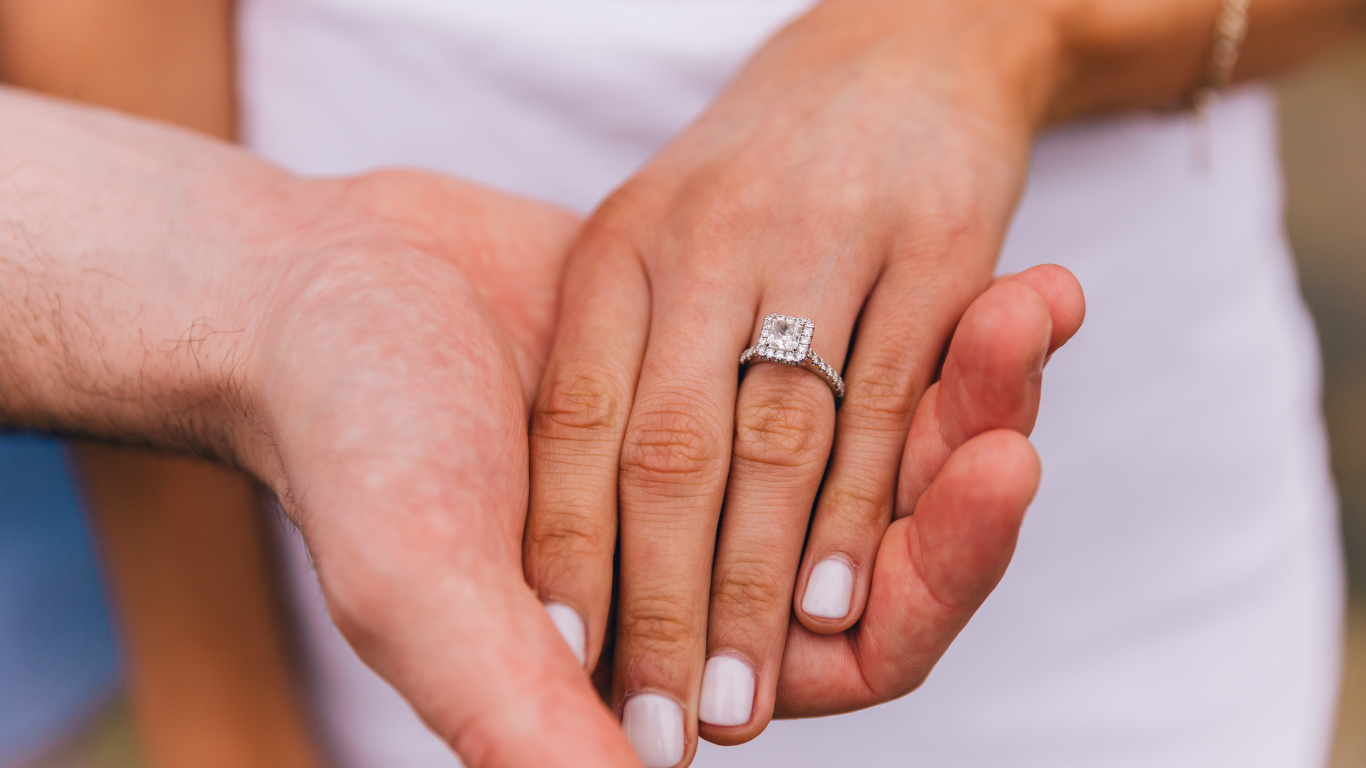Promise rings hold a significant place in modern relationships, symbolizing commitment, love, and often a step toward a deeper bond. However, one common question that arises when it comes to promise rings is, “What finger does a promise ring go on?” In this blog, we’ll cover everything you need to know about promise rings, including their history, meaning, proper placement, and more.
Whether you’re thinking about giving or receiving a promise ring, or you already have one and are unsure which finger it belongs on, this guide will provide all the answers.
1. What is a Promise Ring?
A promise ring is a symbol of commitment, usually given in a romantic relationship. It represents a promise between two people, which can mean different things based on the relationship and the promise being made. This ring is a precursor to other major life events, such as an engagement or marriage, but it doesn’t carry the same weight as an engagement ring.
The promise could be anything from a commitment to remain faithful, a vow to eventually get engaged, or even a symbol of love during a long-distance relationship.
Promise rings are not limited to romantic partners; friends or family members sometimes exchange them to represent a bond or commitment.
2. The Symbolism Behind a Promise Ring
Promise rings can carry various meanings depending on the couple or individuals involved. Here are some of the common symbolisms associated with promise rings:
- Commitment to a Future Together: A promise ring often symbolizes the intention to build a future together, even if the timing for engagement is not right.
- A Vow of Fidelity: Some couples exchange promise rings to represent loyalty and faithfulness, particularly in long-distance relationships.
- Pre-Engagement: For many, a promise ring is seen as a prelude to an engagement ring, indicating that while they aren’t ready for marriage just yet, the couple is committed to each other.
- Purity: A promise ring may also symbolize a vow of purity, where the wearer pledges to remain abstinent until marriage.
Regardless of its meaning, the promise ring is often seen as a serious step in a relationship, cementing the bond between two individuals.
3. The History of Promise Rings
Promise rings have been around for centuries, with their origins traced back to ancient Rome and Greece. These rings, known as “betrothal” or “posy rings,” were exchanged between couples to signify a promise of marriage or love.
In the 16th and 17th centuries, posy rings became popular in England, often engraved with romantic poetry or phrases such as “Love conquers all.” These early promise rings were a sign of love, friendship, and devotion, and the tradition has evolved into what we now know as the modern-day promise ring.
4. What Finger Does a Promise Ring Go On?
Traditionally, a promise ring is worn on the ring finger of the left hand. This is the same finger where engagement and wedding rings are typically placed. The reasoning behind this tradition comes from the ancient belief that the fourth finger of the left hand contains the “vena amoris” (Latin for “vein of love”), which was thought to be directly connected to the heart.
However, the placement of a promise ring is not set in stone and may vary depending on personal preference or cultural differences.
The Tradition in Western Culture
In many Western countries, people opt to wear the promise ring on the left hand’s ring finger if it’s a prelude to an engagement. After getting engaged, the promise ring is typically moved to the right hand to make room for the engagement ring.
For those who are not yet thinking of engagement, wearing the promise ring on the right hand’s ring finger is also a common choice.
Alternatives in Different Cultures
Cultural differences can also influence where the promise ring is worn:
- In some European countries, engagement and wedding rings are worn on the right hand, so a promise ring might also be placed there.
- In Asia, promise rings are often worn on the left ring finger, similar to the Western tradition, but many people feel free to choose any finger depending on their beliefs or preferences.
5. Can a Promise Ring Be Worn on Other Fingers?
Yes! There are no hard rules when it comes to which finger a promise ring should go on. Here are some alternative placements:
- Middle Finger: The middle finger is a popular choice for those who want to keep the ring separate from engagement and wedding rings.
- Index Finger: Wearing a promise ring on the index finger is rare, but it could signify a bold commitment. This finger is more visible and can make the ring stand out.
- Pinky Finger: Some may choose to wear a promise ring on the pinky finger as a sign of individuality.
- Necklace: If wearing a ring on your finger feels uncomfortable or impractical, you can also string it onto a necklace.
Ultimately, the finger you choose to wear your promise ring on depends on what feels right to you.
6. Promise Ring vs. Engagement Ring vs. Purity Ring
While these rings may seem similar, they each have distinct meanings:
- Promise Ring: A commitment between two people that could lead to engagement or marriage in the future, but it’s not guaranteed.
- Engagement Ring: Symbolizes a formal agreement to get married. This is typically worn on the left ring finger and is followed by a wedding ring.
- Purity Ring: Usually worn by individuals making a vow of abstinence until marriage. It may be given by a parent or worn as a personal choice.
7. Popular Styles for Promise Rings
Promise rings come in a variety of styles to suit different preferences. Some of the most popular designs include:
- Simple Bands: Minimalistic bands made from gold, silver, or platinum.
- Gemstone Rings: Rings with a small gemstone, often a birthstone, to add a personal touch.
- Heart-Shaped Designs: Heart-shaped rings are common as a romantic gesture.
- Infinity Symbol Rings: The infinity symbol is often used in promise rings to represent eternal love.
8. When to Give a Promise Ring
There’s no set timeline for giving a promise ring, but it’s usually given when a couple has been together for a significant period of time and wants to solidify their commitment to one another.
- Milestone Occasions: Many people choose to give a promise ring on special occasions like anniversaries, birthdays, or holidays.
- Long-Distance Relationships: If distance separates a couple, a promise ring can act as a physical reminder of their commitment.
- Before Engagement: For some couples, a promise ring represents the promise of an engagement in the future, when both individuals are ready.
9. How to Choose the Right Promise Ring
Choosing the right promise ring depends on personal preference, style, and meaning. Here are some tips:
- Consider the Meaning: Reflect on what the ring symbolizes for your relationship.
- Know the Wearer’s Style: Pay attention to their style—do they prefer bold or minimalistic jewelry?
- Choose a Durable Material: Since promise rings can be worn daily, choosing a durable material like gold, silver, or platinum is a smart decision.
Frequently Asked Questions (FAQs)
1. Which finger does a promise ring go on?
Traditionally, a promise ring is worn on the ring finger of the left hand. However, many choose to wear it on the right hand or other fingers based on personal preference.
2. Can I wear a promise ring on my right hand?
Yes, you can wear a promise ring on your right hand if you wish to reserve your left hand for an engagement or wedding ring.
3. How long should I wait before giving a promise ring?
There’s no set timeline. Many couples give a promise ring when they feel ready to make a commitment, often after a significant period in the relationship.
4. Is a promise ring the same as a purity ring?
No, while both rings symbolize a commitment, a promise ring typically represents a romantic commitment, while a purity ring signifies a vow to abstain from sexual activity until marriage.
5. Can a promise ring be a pre-engagement ring?
Yes, for many couples, a promise ring is a symbol of their intention to eventually get engaged.
Conclusion
In conclusion, the promise ring is a versatile and meaningful piece of jewelry that symbolizes a variety of commitments, depending on the couple. Whether worn on the left or right hand, or even on a different finger altogether, the most important thing about the promise ring is the meaning it holds for the two people involved.




